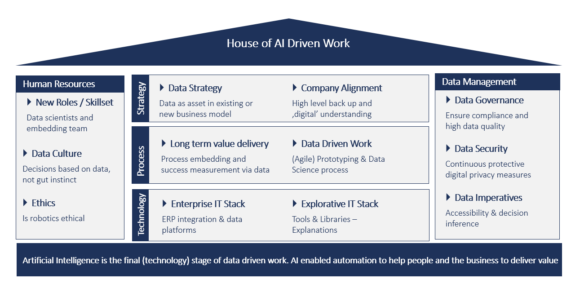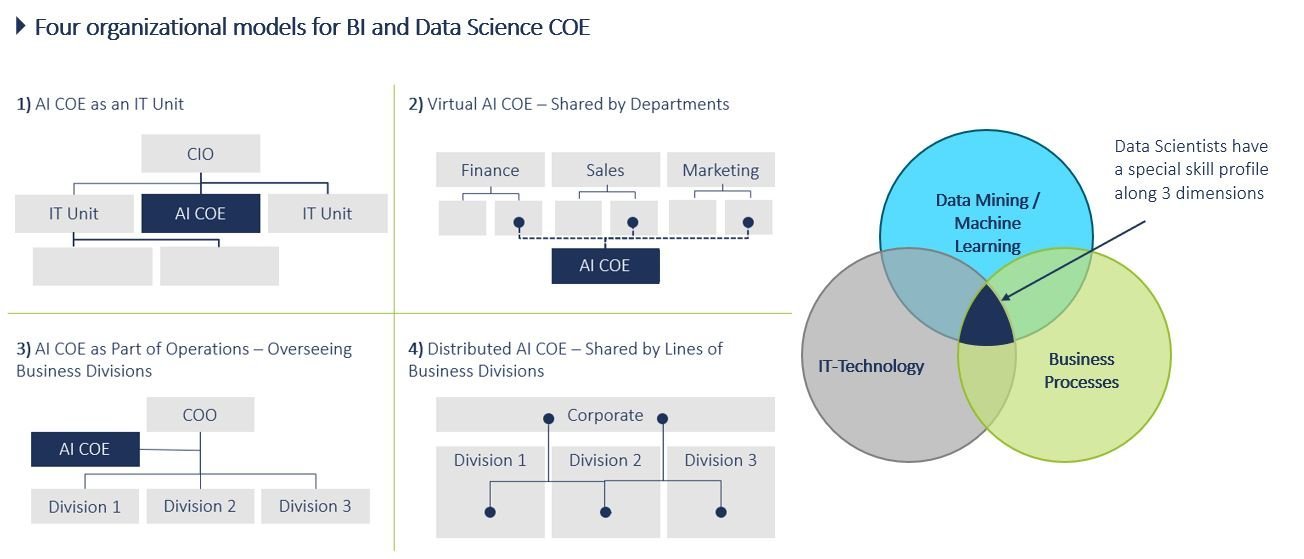As businesses get smarter and smarter, a well-structured and established data strategy becomes key to competitive advantage. What does it mean to become an AI driven company? AI requires the effort of the whole company. It is not only about bringing in new IT platform, hoping it will boost your business. It is actually the architecture of your whole company that would allow you to leverage the new AI capabilities and decision automation that matters most.
Data is the new currency
Since recently, data became a new currency, a very valuable asset that (if effectively managed) brings enormous benefits. Moreover, AI enables the analysis of massive quantities of data and is very efficient in getting insights and creating value. Therefore, automation is one of the key trends across various industries.
For example, in the automotive industry, cars are increasingly connected and generate data that can be leveraged in a number of ways. BMW, for instance, has implemented big data-related technology. Data guides their business development decisions. Other companies are using data to predict when parts would fail or when vehicles need servicing in order to improve driver and passenger convenience. In the financial sector, American Express heavily relies on data analytics and machine learning to help detect fraud and thus saving millions in losses. While big industry leaders implement revolutionary changes to how we can better generate and leverage big data, many of us are still clueless on just how AI is being used today by businesses.
We are certain that the enterprise of the future will be mostly focusing on AI driven decision-making and automation. Businesses will be expected to possess the talent, tools, processes, and capabilities to enable their companies to implement and utilize AI solutions.
Architecture
The House of AI Driven Work (see Figure 1) provides a clear blueprint of effective use of a company’s biggest strategic asset: data.
 Figure 1: House of AI Driven Work
Figure 1: House of AI Driven Work
The starting point of the AI driven transformation of your company is defining clear objectives and outcomes to be delivered. This should be focused on the expected business outcomes from AI and automation across the business – from strategy definition to process and technology adjustments. Most importantly, the AI and decision automation assessment should be impact-driven, not budget-driven as it is critical to see the full lifecycle of these engagements.
Human Resources
In order to ensure the smooth way of AI implementation, the company must establish a team of skilled data scientists, or AI Center of Excellence (AI COE). There are four organizational models of embedding such a team into a company’s structure. First, the team could operate as a separate IT unit that reports to the CIO and is responsible for AI solutions used in the company. Second, the team could assist all departments, according to their needs. Third, the organizational model could be that the team is overseeing all business divisions and is part of strategic operations. And lastly, the team could act as a so-called distributed AI COE where AI is embedded in all divisions. This is the most advanced HR structure for the front runners in AI driven businesses.
 Figure 2: HR Embedding and data scientists’ skill profile
Figure 2: HR Embedding and data scientists’ skill profile
What also needs to be cultivated is the data culture. It is crucial that business decisions are data-driven, not driven by gut instinct. Data-driven culture ensures that strategic decision-making process is consistent, repeatable, and transparent.
Furthermore, while data science provides huge opportunities to improve our lives and environment, the ethics must be considered:
- The ethics of data (how data is generated, recorded and shared)
- The ethics of algorithms (how AI, machine learning and robots interpret data)
- The ethics of practices (devising responsible innovation and professional codes to guide this emerging science)
Strategy, Process and Technology
Data is an asset in existing or new business model. That’s why a clear data strategy needs to be defined within an organization. The latest information technologies must be embedded and able to co-exist with old technologies. Business leaders must re-evaluate business objectives and plan to make a better use of analytics to achieve those goals, e.g. digitalization. The overall data strategy must be supported by high level back up and “digital” understanding. For this reason, one should focus on data architecture and technology that ensures consistency around technology changes and know-how introduction.
Next, a clear data science process has to be followed in order to lift the long-term value through data work. For example, Camelot has defined its own data science process which is tailored to value chain management. Similar to CRISP (Cross-Industry Standard Process for Data Mining), it starts with the business understanding, goes through the data exploration, data analysis, and applying appropriate ML techniques. As an output we typically get a prototype that is further embedded into the relevant business process and its success can be measured continuously.
In terms of technology, the company can choose to either deploy a ready plug & play solution to its ERP system or take a (longer) explorative approach and tailor innovative solutions to the business needs. The latter would of course need more investment, skilled data scientists and developers, as well as continuous delivery, testing, and monitoring.
Data Management
Well-managed data is not an easy task. Establishing an effective data governance is one of the most important steps to connect business strategy with information policy. Company’s data can be accounted for an asset only if it is high-quality, well-structured, accessible, and continuously protected.
Several factors affect the complexity of data governance:
- Data ownership questions
- Data inconsistencies across different departments
- Expanding use of big data in companies
The building blocks of data driven work enable companies to build a solid AI structure leading them towards a successful digital transformation. As with any process, however, companies should tailor these steps around data strategy, so they can better implement emerging AI tools and meet business goals.
We would like to thank Frank Kienle for his valuable contribution to this article.
